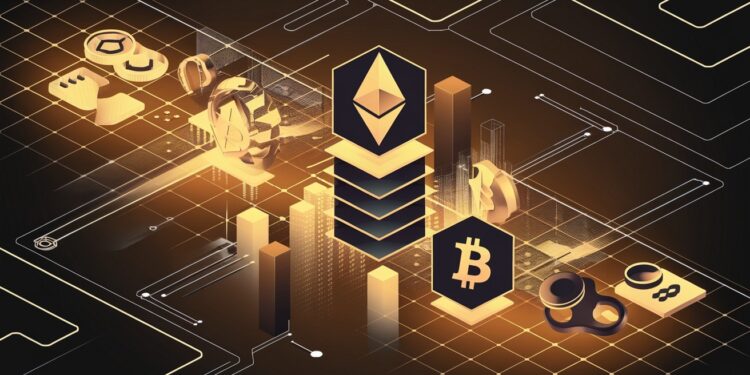Imagine a world where financial services are accessible to all, unbound by geographical borders or centralized control. Welcome to the realm of Decentralized Finance (DeFi) – a revolutionary paradigm shift that is reshaping the global economic landscape in the digital era. Built on the bedrock of blockchain technology and powered by smart contracts, DeFi is ushering in a new age of financial inclusion, transparency, and innovation.
The DeFi Ecosystem: A Catalyst for Change
At its core, DeFi represents a decentralized ecosystem of financial applications and protocols that operate on blockchain networks. By leveraging the immutable and transparent nature of distributed ledger technology, DeFi eliminates the need for intermediaries and central authorities. This paradigm shift empowers individuals with unprecedented control over their financial assets and enables peer-to-peer interactions on a global scale.
Unlocking Financial Inclusion
One of the most transformative aspects of DeFi is its potential to promote financial inclusion. Traditional banking systems have long excluded billions of individuals worldwide due to barriers such as lack of infrastructure, high costs, and stringent requirements. DeFi breaks down these barriers by providing access to a wide range of financial services through a simple internet connection and a digital wallet.
DeFi has the power to create a more inclusive and equitable financial system that serves the needs of individuals, regardless of their geographical location or socioeconomic status.
– Vitalik Buterin, Co-Founder of Ethereum
The Rise of Decentralized Lending and Borrowing
One of the cornerstone applications of DeFi is decentralized lending and borrowing. Platforms like Aave and Compound enable users to lend their digital assets and earn interest, while borrowers can access loans without the need for traditional credit checks or collateral. This decentralized approach to lending democratizes access to capital and promotes a more efficient allocation of resources.
- Crypto Lending Platforms: Aave, Compound, MakerDAO
- Benefits: Accessibility, Transparency, Efficiency
Decentralized Exchanges (DEXs): Empowering Peer-to-Peer Trading
Another key pillar of DeFi is the rise of decentralized exchanges (DEXs). Unlike traditional centralized exchanges, DEXs facilitate peer-to-peer trading of digital assets without the need for intermediaries. By leveraging smart contracts and liquidity pools, DEXs provide a secure, transparent, and efficient trading environment. This decentralized approach mitigates the risks associated with centralized exchanges, such as hacking, fraud, and censorship.
| DEX | Total Value Locked (TVL) | Daily Trading Volume |
| Uniswap | $7.1 Billion | $1.2 Billion |
| SushiSwap | $4.5 Billion | $400 Million |
| PancakeSwap | $4.2 Billion | $600 Million |
Stablecoins: Bridging the Gap Between Traditional and Decentralized Finance
Stablecoins play a crucial role in the DeFi ecosystem by providing a stable and reliable means of value transfer. Pegged to fiat currencies or backed by collateral, stablecoins mitigate the volatility associated with cryptocurrencies. They serve as a bridge between traditional finance and the decentralized world, enabling seamless integration and facilitating the adoption of DeFi solutions.
- Popular Stablecoins: Tether (USDT), USD Coin (USDC), Dai (DAI)
- Use Cases: Remittances, Payments, Trading Pairs
Yield Farming and Liquidity Mining: Incentivizing Participation
DeFi has introduced innovative mechanisms to incentivize user participation and liquidity provision. Yield farming involves users locking up their digital assets in DeFi protocols to earn rewards in the form of additional tokens. Similarly, liquidity mining rewards users for contributing liquidity to DEXs, ensuring a smooth trading experience. These incentive models have attracted a significant influx of capital into the DeFi space, driving its exponential growth.
Yield farming and liquidity mining have revolutionized the way users interact with DeFi protocols, creating a vibrant and dynamic ecosystem that rewards active participation.
– Andre Cronje, Founder of Yearn Finance
The Future of DeFi: Interoperability and Scalability
As the DeFi ecosystem continues to evolve, the focus is shifting towards interoperability and scalability. Interoperability enables seamless communication and asset transfer between different blockchain networks, unlocking new possibilities for cross-chain DeFi applications. Meanwhile, scalability solutions, such as layer-2 protocols and sharding, are being developed to address the challenges of high transaction fees and network congestion.
The future of DeFi holds immense potential, with the promise of a more inclusive, transparent, and efficient global financial system. As more individuals and institutions embrace decentralized solutions, the traditional financial landscape will undergo a profound transformation. The convergence of DeFi with other emerging technologies, such as artificial intelligence and internet of things, will further accelerate innovation and unlock new possibilities.
In conclusion, Decentralized Finance represents a paradigm shift that is reshaping the global economic landscape in the digital era. By leveraging blockchain technology and smart contracts, DeFi is democratizing access to financial services, promoting transparency, and fostering innovation. As the ecosystem continues to mature and overcome challenges, DeFi has the potential to create a more equitable and inclusive financial future for all.








